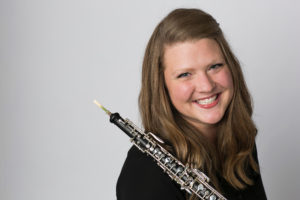 There are two things about our next program, Scintillating Summer Serenades, that say a lot about who Midsummer’s Music is and what we do. The first is the combination on the program of a major composer (Mozart) with two unknown gems (by Wranitzky and Molique). The other is the combination of instruments involving flute, oboe, and strings.
There are two things about our next program, Scintillating Summer Serenades, that say a lot about who Midsummer’s Music is and what we do. The first is the combination on the program of a major composer (Mozart) with two unknown gems (by Wranitzky and Molique). The other is the combination of instruments involving flute, oboe, and strings.
Let’s begin with the second—our varied instrumentation. We present a variety of combinations of winds, strings, and/or piano. Moreover, we try to mix up the instrumentations on a given program so that the listener experiences an evolving spectrum of sounds. I have been quoted as saying, we are much like the Door Co. weather—constantly changing. This isn’t an accident. When we first contemplated the idea of Midsummer’s Music, we were aware that we had to overcome a negative connotation about “chamber” music among some listeners. For many, chamber music had come to be synonymous with string quartet music. And why not? The chamber music world was dominated by great string quartets with names like Emerson, Tokyo, Vermeer, Cleveland, Pro Arte, Budapest, Fine Arts—Some of the greatest musical ensembles ever known. They played in the great concert halls of London, Boston, Vienna, New York, Chicago. And, they played much the same repertoire – the rich repertoire of the masters they were so blest with – works by Beethoven, Mozart, Debussy, Brahms, Mendelssohn, Shostakovich, Haydn. More about the repertoire in a moment.
This was both a blessing and a curse. For the string quartet aficionado, this was a sumptuous repas, a splendid feast. However, every string quartet is made of up the same instrumentation (two violins, a viola, and a cello), and much as they may be able to vary that, the sound is always a string sound. And, most of these performances are presented in a concert hall, many of which are really too big for a four-piece ensemble. Orchestra Hall in Chicago seats about 2,500 people and has three balconies. The large main floor alone is way larger than any place where we perform. Furthermore, they play on a high stage, well separated from the closest audience members.
There is clearly a dedicated group of devotees to string quartet music who will attend their favorite ensembles performances wherever they appear. As an aside, when I was Principal Bassoon at Lyric Opera of Chicago and we would do Wagner’s complete ring cycle (18 hours over four nights), there would be people in the audience who were there from all over the world. They went to the Ring anywhere it was being performed and many had heard the complete cycle over 100 times. As tremendous as this music is, most of us also want our La Bohemes, our Lucia di Lamamours, our Carmens, and we also appreciate a little more variety in our chamber music as well.
Our intention with Midsummer’s, from the beginning, was to get back to the aspects of chamber music that made it appealing in the first place, two or three hundred years ago. In those days, it might be performed in the home of the nobility for a gathering of quests, for a special occasion, or simply for some needed diversion. But it was performed in a room. It might be a ballroom, or large salon, but it was a room—you might even call it a chamber. It was rarely played on a stage. It was performed among the audience, not in separated from them (by a stage). It also might be performed in a more modest home for recreation involving whatever instruments those gathered could muster. In this case it was sometimes called Hausmusik in German, or Salon music in French, but it was for the middle class, and it was for fun and good times. It might even be called Tafelmusik because it was played with the performers sitting around a table. One can easily imagine the food and beverages that accompanied such get-togethers.
This camaraderie, this Gemütlichkeit, this intimacy and sense of involvement between performers and listeners, was something we wanted to get back to and incorporate into our Midsummer’s Music experience. We wanted a satisfying variety, a feeling of discovery, and a deep sense of involvement in the unfolding performance. We are slowly making converts as more and more people discover the magic of what made chamber music special from the beginning.
 Nowhere will all this be on display more so than in what you will experience during the four concerts of our next program, Scintillating Summer Serenades, which starts Thursday, July 7, at the Kress Pavilion in Egg Harbor at 7:00. Continuing our exposure to Mozart from our most recent program, we will explore a work of his for oboe and strings, the Oboe Quartet in F Major, K386b. This could easily be described as the greatest chamber work involving oboe ever written. It is also as challenging and rewarding as that description would suggest. Lindsay Flowers, faculty member at UW–Madison, returns as our featured oboist and will be joined by David Perry, violin; Allyson Fleck, viola; and James Waldo, cello. Lindsay has all of the facility and command of her instrument to meet the demands of this amazing work, and her performances of it should not be missed.
Nowhere will all this be on display more so than in what you will experience during the four concerts of our next program, Scintillating Summer Serenades, which starts Thursday, July 7, at the Kress Pavilion in Egg Harbor at 7:00. Continuing our exposure to Mozart from our most recent program, we will explore a work of his for oboe and strings, the Oboe Quartet in F Major, K386b. This could easily be described as the greatest chamber work involving oboe ever written. It is also as challenging and rewarding as that description would suggest. Lindsay Flowers, faculty member at UW–Madison, returns as our featured oboist and will be joined by David Perry, violin; Allyson Fleck, viola; and James Waldo, cello. Lindsay has all of the facility and command of her instrument to meet the demands of this amazing work, and her performances of it should not be missed.
 She will also be heard in performances of a Sextet for Flute, Oboe, and Strings by Paul Wranitzky and will be joined by flutist Heather Yarmel from the Milwaukee Symphony. I know, Wranitzky sounds like your butcher down on Cermak in Chicago. I didn’t know about him either until I discovered this delightful three-movement work. Wranitzky was born the same year as Mozart. Like so many Czechs, he migrated from his native Moravia to Vienna when he was 20, so he was already there when Mozart arrived from Salzburg in 1782. For me, I can sum up this music with one word: Vivacious. It is spirited, ingratiating, and charming, almost like a little symphony of the time and shows off the flute and oboe sounds beautifully against the strings. It is a perfect prelude to the Mozart Oboe Quartet that follows.
She will also be heard in performances of a Sextet for Flute, Oboe, and Strings by Paul Wranitzky and will be joined by flutist Heather Yarmel from the Milwaukee Symphony. I know, Wranitzky sounds like your butcher down on Cermak in Chicago. I didn’t know about him either until I discovered this delightful three-movement work. Wranitzky was born the same year as Mozart. Like so many Czechs, he migrated from his native Moravia to Vienna when he was 20, so he was already there when Mozart arrived from Salzburg in 1782. For me, I can sum up this music with one word: Vivacious. It is spirited, ingratiating, and charming, almost like a little symphony of the time and shows off the flute and oboe sounds beautifully against the strings. It is a perfect prelude to the Mozart Oboe Quartet that follows.
On the second half is another stunning discovery. When I first came across the Quintet for Flute and Strings by Bernhard Molique, I thought, based on his last name, that Molique must be French. I was therefore surprised to learn that he was born in Nuremberg. Born in 1802, he is the youngster on our program and fits in nicely with the German/Vienna thread of this music. This Quintet, which will feature our flutist Heather Yarmel is a tremendous find. I can’t wait for you to hear it and to hear how Heather brings it to life. It is ravishing, enrapturing, and brilliant in her hands. These two discoveries by Wranitzky and Molique are as new to me as they are to you, but that’s part of what Midsummer’s Music is all about—learning and gaining a new perspective as we, in this case, incapsulate one of the great works of Mozart with two of his rather extraordinary contemporaries. You will note that both the Wranizky and Molique works are scored for a string quartet that includes two violas (only one violin). This was not entirely uncommon at the time and lends a certain extra warmth and body to the sound of the ensemble. Don’t miss this chance to explore and enjoy this enticing music in the hands of the most exceptional musicians. It is a rare treat and opportunity.
Performances take place in the intimate and enjoyable ambiance of the …
- Kress Pavilion in Egg Harbor on July 7 at 7:00 pm
- First Baptist Church of Sister Bay on Friday, July 8, at 7:00 pm
- St. Luke’s Episcopal Church, Sister Bay on Saturday, July 9, at 7:00 pm
- Woodwalk Gallery, Egg Harbor, Sunday, July 10, at 5:00 pm
For tickets or more information, please call 920-854-7088 or visit www.midsummersmusic.com. We look forward to sharing this music and this experience with you.
Jim Berkenstock
Artistic Director
